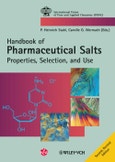Altogether, the contributions to this book by international team of authors from academia and pharmaceutical industry reflect the multidisciplinary nature of the science involved in selection of suitable salt forms for new drug products. They present the necessary theoretical foundations as well as a wealth of detailed practical experience in the choice of pharmaceutically active salts, taking great care to address every conceivable aspect of the preparation of pharmaceutical salts.
An introductory chapter presents a concise review of the various objectives in the pursuit of pharmaceutically active salts, followed by the theoretical background of salt formation. There then follow chapters on the practice of salt formation in an industrial R&D environment, as well as regulatory and patent issues. Practical examples for the practitioners at the lab bench are provided, before the book concludes with a comprehensive annotated compilation of the individual salt-forming acids and bases with their relevant properties, followed by an appendix containing tables with the acids and bases sorted alphabetically and by pKa, supplemented with other useful facts and data.
An essential reference for students of medicinal and pharmaceutical chemistry, and an indispensable handbook for R&D chemists, analytical chemists, biologists, development pharmacists, regulatory and patent specialists, and medicinal scientists engaged in preclinical development of drugs. In addition, this comprehensive and up-to-date guide is an instructive companion for all scientists involved in the research and development of drugs and, in particular, of pharmaceutical dosage forms.
Table of Contents
Introduction (Camille G. Wermuth and P. Heinrich Stahl).Chapter 1. The Physicochemical Background: Fundamentals of Ionic Equilibria (Michael B. Maurin, David J. W. Grant, and P. Heinrich Stahl).
Chapter 2. Solubility and Dissolution of Weak Acids, Bases, and Salts (Madhu Pudipeddi, Abu T. M. Serajuddin, David J. W. Grant, and P. Heinrich Stahl).
Chapter 3. Evaluation of Solid-State Properties of Salts (Danielle Giron and David J. W. Grant).
Chapter 4. Pharmaceutical Aspects of the API Salt Form (P. Heinrich Stahl and Finlay S. Skinner).
Chapter 5. Biological Effects of the API Salt Form (Friedlieb Pfannkuch, Harald Rettig, and P. Heinrich Stahl).
Chapter 6. Salt-Selection Strategies (Abu T. M. Serajuddin and Madhu Pudipeddi).
Chapter 7. A Procedure for Salt Selection and Optimization (Michael J. Bowker).
Chapter 8. High-Throughput Strategies and Techniques for Salt Screening (Nicole Wyttenbach, Bertrand Sutter, and Pirmin Hidber).
Chapter 9. Large-Scale Aspects of API Salt Manufacture (Piotr H. Karpiński).
Chapter 10. Patent Aspects of API Salt Formation (Hans-Günther Foraita).
Chapter 11. Regulatory Aspects of API Salts (Maria Arfwedson and Alan Chalmers, Jun-ichi Kondo and P. Heinrich Stahl, and Mansoor A. Khan and Vilayat A. Sayeed).
Chapter 12. Selected Procedures for the Preparation of Pharmaceutically Acceptable Salts (Camille G. Wermuth and P. Heinrich Stahl).
Chapter 13. Monographs on Acids and Bases (P. Heinrich Stahl and Camille G. Wermuth).
Appendix (P. Heinrich Stahl).
Subject-Index.
Substance-Index.








